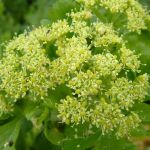| Common Name: |
Black Lovage |
| Other Names: |
Alexanders |
| Botanical Name: |
Smyrnium olusatrum |
| Genus: |
Smyrnium |
| Family: |
Apiaceae |
| Native Location: |
Europe, SW Asia and N Africa |
| Cultivation: |
Moist, rich, sandy soil in sun. |
| Propagation: |
By seed sown in late summer or early spring. |
| Harvest: |
Leaves, young stems and shoots, and flower buds are picked in spring and early summer. Roots are lifted in autumn. All parts are used fresh. Seeds are collected when ripe and stored whole or ground. |
| Height: |
50cm-1.5m (1¾-5ft) |
| Width: |
30-90cm (12-36in) |
| Hardiness: |
Z7-10 |
| Parts Used: |
Leaves, young stems and shoots, roots, flowers, seeds. |
| Properties: |
A bitter, diuretic herb, with a celery-like flavor, that benefits the digestion. |
| Medicinal Uses: |
Medicinal uses are obsolete. |
| Culinary Uses: |
Leaves, young leaf stalks, shoots, and roots are cooked as vegetables, and added to soups and stews. Flower buds make a pleasant addition to salads. Spicy seeds may be ground as a condiment. |
| Bibliography: |
The Encyclopedia of Herbs by Deni Bown Copyright © 1995, 2001 Dorling Kindersley Limited pg 371 |

